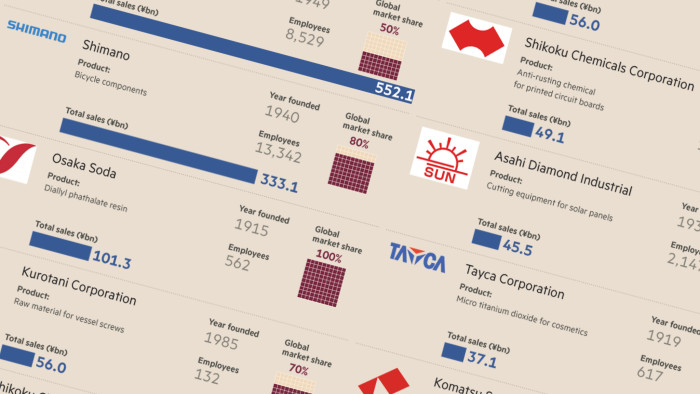Japan ‘hidden treasures’ companies fear for their security

Roula Khalaf, Editor of the FT, selects her favourite stories in this weekly newsletter.
They are the nuts and bolts of daily life — rust-resistant screws, machinery for making instant noodles and the clocks used to time triathlon events precisely are overwhelmingly made in Japan. Their producers are Japan’s “hidden treasures” — companies that command global market shares of at least 50 per cent although few Japanese, let alone foreigners, have ever heard of them.
Many of these products are vital to global supply chains, as car factories in Germany, Brazil, Britain and the US discovered within two weeks of the 2011 earthquake off Japan’s Pacific coast. Supplies of specialist components — in this case, vibration-proof LCD screens, airflow sensors and two particular shades of metallic paint — dwindled fast after plants were destroyed by the quake and subsequent tsunami.
A few “hidden treasures” such as Shimano, which has three-quarters of the global market for bicycle brakes and gears, are known abroad. But in many cases, world leaders in their niches occupy ageing buildings on the edge of dreary industrial parks.
Fish and seafood processors everywhere rely on the machinery of Towa Denki and Nikko, while anyone planning to open a public aquarium is more or less obliged to buy their large acrylic viewing panes from Nippura. Countries aspiring to build nuclear power plants must join an international queue for a crucial part of the reactor core made in a single Hokkaido furnace by Japan Steel Works. Wig-makers around the world source 50 per cent of their acrylic imitation hair from Kaneka Corporation.
Japan’s semiconductor industry may have been overtaken by competitors in Taiwan, South Korea and China, but all those upstarts still buy their silicon wafer polishers from Japan.
The FT and Nikkei is publishing a list of 29 leading “hidden treasures”, bringing them out of the shadow of Japan’s long battle with stagnation and the decline of great names such as Sharp, Panasonic and Toshiba.
Yet even the “hidden treasures” feel insecure. In interviews with the FT and Nikkei, the chiefs of three such companies voiced shared fears of the difficulty of attracting brilliant innovators from a shrinking population; the lack of expertise in globalising operations and a permanent risk of disruptive technology.
Source: Nikkei
Comments